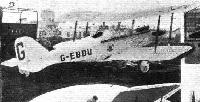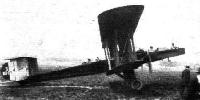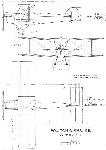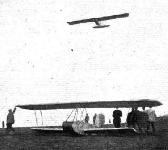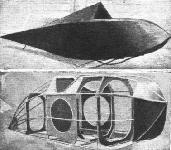Фотографии
-
D.H.9, 230 h.p. Siddeley "Puma."
Самолёты на фотографии: De Havilland D.H.9 - Великобритания - 1917
-
Регистрационный номер: G-EBEP SOME OF THE STARTS FOR THE KING'S CUP RACE: Capt. Muir starting on the D.H.9;
Самолёты на фотографии: De Havilland D.H.9 - Великобритания - 1917
-
Регистрационный номер: G-EBEN THE RACE FOR THE KING'S CUP: Ten of the faster machines, arranged in the order of starting: 6, D.H.9;
Самолёты на фотографии: De Havilland D.H.9 - Великобритания - 1917
-
Регистрационный номер: G-EBCG SOME OF THE STARTS FOR THE KING'S CUP RACE: Perry gets off on the D.H.9A;
Самолёты на фотографии: De Havilland D.H.9A - Великобритания - 1918
-
THE RACE FOR THE KING'S CUP: Ten of the faster machines, arranged in the order of starting: 7, D.H.9A;
Самолёты на фотографии: De Havilland D.H.9A - Великобритания - 1918
-
Регистрационный номер: G-EBDU THE RACE FOR THE KING'S CUP: Ten of the faster machines, arranged in the order of starting: 8, S.E.5A;
Самолёты на фотографии: RAF S.E.5 - Великобритания - 1916
-
The Blackburn Kangaroo, 2-275 h.p. Rolls-Royce "Falcons"
Самолёты на фотографии: Blackburn Kangaroo / R.T.1 - Великобритания - 1917
-
THE RACE FOR THE KING'S CUP: Photographs of the competing machines. Avro Lucifer.
Самолёты на фотографии: Avro Avro 504 - Великобритания - 1913
-
Filling up Courtney's Siddeley "Siskin" before the start.
Самолёты на фотографии: Armstrong Whitworth Siskin - Великобритания - 1921
-
Регистрационный номер: G-EBEU SOME OF THE STARTS FOR THE KING'S CUP RACE: Courtney zooms off in a left-hand turn on the Siddeley Siskin.
Самолёты на фотографии: Armstrong Whitworth Siskin - Великобритания - 1921
-
Регистрационный номер: G-EAVP Bristol Monoplane, 100 h.p. Bristol "Lucifer."
Самолёты на фотографии: Bristol M.1A / M.1B / M.1C - Великобритания - 1916
-
Регистрационный номер: G-EASJ [3] THE BOULTON AND PAUL P.9. BIPLANE: Three-quarter rear view.
Самолёты на фотографии: Boulton Paul P.6 / P.9 - Великобритания - 1918
-
Регистрационный номер: G-EASJ [3] THE BOULTON AND PAUL P.9. BIPLANE: Three-quarter front view.
Самолёты на фотографии: Boulton Paul P.6 / P.9 - Великобритания - 1918
-
THE BOULTON AND PAUL P.9. BIPLANE: The 90 h.p. air-cooled R.A.F. engine fitted to this machine.
Самолёты на фотографии: Boulton Paul P.6 / P.9 - Великобритания - 1918
-
Регистрационный номер: G-EASJ [3] The Boulton and Paul P. 9 two-seater, with 90 h.p. R.A.F. engine.
Самолёты на фотографии: Boulton Paul P.6 / P.9 - Великобритания - 1918
-
THE BOULTON AND PAUL P.9. BIPLANE: 1. The engine rev.-indicator is mounted in a streamline casing outside the fuselage, where it is clearly visible from both cockpits. 2. The simple adjustment for tailplane incidence. 3. The neat luggage boot behind the rear cockpit. Inset is the simple and effective fastener securing the cover in position. 4. The tail skid, which is connected up to the rudder bar to facilitate steering when taxying.
Самолёты на фотографии: Boulton Paul P.6 / P.9 - Великобритания - 1918
-
Boulton & Paul P.9. 90 hp R.A.F. 1a
Самолёты на фотографии: Boulton Paul P.6 / P.9 - Великобритания - 1918
-
A NEW ALL-STEEL AEROPLANE: Three photographs of the Boulton and Paul "Bolton" (Series number P.15). The Air Ministry has sanctioned publication of these photographs, but no information relating to the machine may be given beyond such details as are disclosed in the photographs. From these it will be seen that the machine is similar, in general lines, to the Boulton and Paul "Bourges," but the detail construction is, of course, quite different. The power plant, it will be seen, consists of two Napier "Lion" engines.
Самолёты на фотографии: Boulton Paul P.15 Bolton / P.25 Bugle - Великобритания - 1922
-
THE AERIAL DERBY. Photographs of the starters. Avro Baby single-seater, 35 h.p. Green.
Самолёты на фотографии: Avro Baby / Type 534 - Великобритания - 1919
-
THE RACE FOR THE KING'S CUP: Photographs of the competing machines. Avro Baby.
Самолёты на фотографии: Avro Baby / Type 534 - Великобритания - 1919
-
Регистрационный номер: G-EAUM SOME OF THE STARTS FOR THE KING'S CUP RACE: The Avro Baby gets away;
Самолёты на фотографии: Avro Baby / Type 534 - Великобритания - 1919
-
Siddeley "Siskin," 325 h.p. Siddeley "Jaguar."
Самолёты на фотографии: Armstrong Whitworth (Siddeley) S.R.2 Siskin - Великобритания - 1919
-
Регистрационный номер: G-EBEV The Bristol 10-seater, 400 h.p. Bristol "Jupiter."
Самолёты на фотографии: Bristol Ten-Seater / Brandon - Великобритания - 1921
-
An Impression of "Mars I."
Самолёты на фотографии: Gloster Mars (Bamel) / Nighthawk / Sparrowhawk - Великобритания - 1921
-
Baron Freyberg is seen flying the Hart-Messerschmidt monoplane. Note the central skid and open tail boom girder.
Самолёты на фотографии: Messerschmitt S8 - S13 - Германия - 1921
-
THE HART-MESSERSCHMIDT FUSELAGE MONOPLANE: This is an experimental type, the standard machine having open tail girders and no cockpit.
Самолёты на фотографии: Messerschmitt S8 - S13 - Германия - 1921
-
THE RACE FOR THE KING'S CUP: Photographs of the competing machines. Sopwith Gnu.
Самолёты на фотографии: Sopwith Gnu - Великобритания - 1919
-
Регистрационный номер: G-EBDK THE FIRST THREE MACHINES HOME: Barnard's D.H.4A (the winner); Raynham's Martinsyde F.6; and Cobham's D.H.9B, lined up in front of the enclosures.
Самолёты на фотографии: De Havilland D.H.9B / D.H.9C - Великобритания - 1919Martinsyde F.4A / F.6 / A - Великобритания - 1919
-
The Record Breaker: Herr Hentzen, in the cockpit of his famous "Vampyr," on which he remained aloft for 3 hrs. 10 mins. This machine, as distinct from the Hannover "Greif," has a flat-sided fuselage.
Самолёты на фотографии: Hannover H.1 Vampyr / H.2 Greif / Strolch - Германия - 1921
-
The Hannover Glider "Vampyr," on which Herr Hentzen remained aloft for over three hours.
The Vampyr soaring overhead during 1922. The wingtips had been completely rebuilt with wing warping instead of ailerons for lateral control. Fabric covering was used above and below the fuselage, the sides being plywood.Самолёты на фотографии: Hannover H.1 Vampyr / H.2 Greif / Strolch - Германия - 1921
-
The Hannover "Greif" (Condor) is a refined edition of the famous "Vampyr," but has not yet been sufficiently tuned up to do very extended flights, although a number of very creditable flights have been made on it. The monoplane wing has a pronounced taper, and the fuselage is carefully streamlined. The right-hand photograph, which shows the "Greif" in flight, gives a good idea of the Rhon hills.
Самолёты на фотографии: Hannover H.1 Vampyr / H.2 Greif / Strolch - Германия - 1921
-
Lady Anne Savile in the cabin of her D.H.9C, piloted by Flying Officer Leslie Hamilton.
Самолёты на фотографии: De Havilland D.H.9B / D.H.9C - Великобритания - 1919
-
Регистрационный номер: G-EBAX THE RACE FOR THE KING'S CUP: Ten of the faster machines, arranged in the order of starting: 2, D.H.9c (230 h.p. Siddeley "Puma")
Самолёты на фотографии: De Havilland D.H.9B / D.H.9C - Великобритания - 1919
-
THE RACE FOR THE KING'S CUP: Ten of the faster machines, arranged in the order of starting: 3, D.H.9B;
Самолёты на фотографии: De Havilland D.H.9B / D.H.9C - Великобритания - 1919
-
The D.H.9B, 230 h.p. Siddeley "Puma."
Самолёты на фотографии: De Havilland D.H.9B / D.H.9C - Великобритания - 1919
-
Регистрационный номер: G-EAYT The D.H.9c, 230 h.p. Siddley "Puma."
Самолёты на фотографии: De Havilland D.H.9B / D.H.9C - Великобритания - 1919
-
Регистрационный номер: G-EAMU [2] The winning machine comes to a standstill. Capt. Barnard greeted by admirers.
Самолёты на фотографии: De Havilland D.H.4A - Великобритания - 1919
-
Регистрационный номер: G-EAMU [2] THE RACE FOR THE KING'S CUP: Ten of the faster machines, arranged in the order of starting: 9, D.H.4A (winner of the race);
Самолёты на фотографии: De Havilland D.H.4A - Великобритания - 1919
-
The Darmstadt monoplane, piloted by Bottsch, flying over the Dresden biplane.
Самолёты на фотографии: Darmstadt D-04 - D-07 - Германия - 1922Dresden D-B01 Stehaufchen - Германия - 1921
-
TWO DARMSTADT FUSELAGES: Top, the body of the Type 4 monoplane; bottom, the nacelle of the biplane.
Самолёты на фотографии: Darmstadt D-04 - D-07 - Германия - 1922
-
THE THREE DARMSTADT MACHINES: General arrangement drawings.
Самолёты на фотографии: Darmstadt D-04 - D-07 - Германия - 1922
-
The Dresden biplane is shown just after getting away. Note the two men holding the starting rope.
Самолёты на фотографии: Dresden D-B01 Stehaufchen - Германия - 1921
-
THE BELLANCA CF 5-SEATER "SESQUIPLAN": Three-quarter front view.
Самолёты на фотографии: Bellanca CF - США - 1922
-
THE BELLANCA CF 5-SEATER "SESQUIPLAN": Front view.
Самолёты на фотографии: Bellanca CF - США - 1922
-
THE BELLANCA CF 5-SEATER "SESQUIPLAN": Rear view, showing the pilot's cockpit.
Самолёты на фотографии: Bellanca CF - США - 1922
Статьи
- Flight





